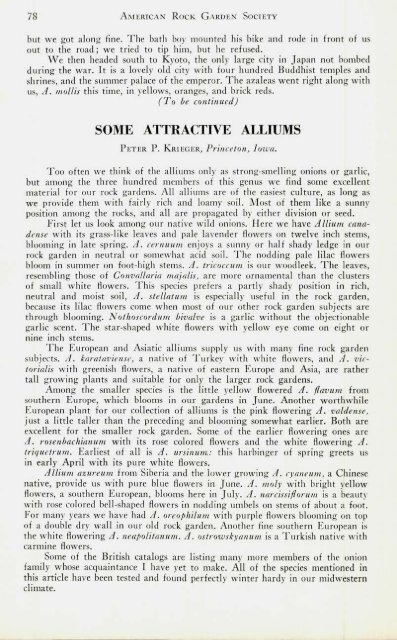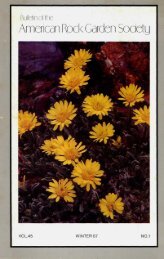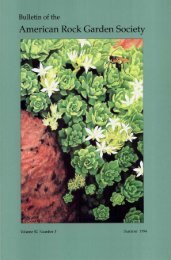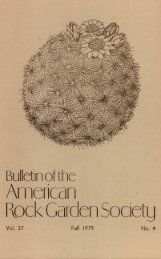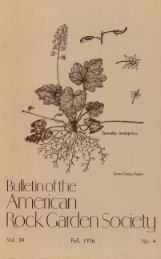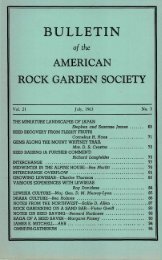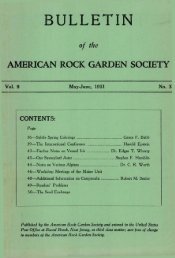Bulletin - July 1956 - North American Rock Garden Society
Bulletin - July 1956 - North American Rock Garden Society
Bulletin - July 1956 - North American Rock Garden Society
Create successful ePaper yourself
Turn your PDF publications into a flip-book with our unique Google optimized e-Paper software.
78 AMERICAN ROCK GARDEN SOCIETYbut we got along fine. The bath boy mounted his bike and rode in front of usout to the road; we tried to tip him, but he refused.We then headed south to Kyoto, the only large city in Japan not bombedduring the war. It is a lovely old city with four hundred Buddhist temples andshrines, and the summer palace of the emperor. The azaleas went right along withus, A. mollis this time, in yellows, oranges, and brick reds.(To be continued)SOME ATTRACTIVEPETER P. KRIEGER, Princeton,ALLIUMSIowa.Too often we think of the alliums only as strong-smelling onions or garlic,but among the three hundred members of this genus we find some excellentmaterial for our rock gardens. All alliums are of the easiest culture, as long aswe provide them with fairly rich and loamy soil. Most of them like a sunnyposition among the rocks, and all are propagated by either division or seed.First let us look among our native wild onions. Here we have A Ilium canadensewith its grass-like leaves and pale lavender flowers on twelve inch stems,blooming in late spring. A. cernuum enjoys a sunny or half shady ledge in ourrock garden in neutral or somewhat acid soil. The nodding pale lilac flowersbloom in summer on foot-high stems. A. tricoccum is our woodleek. The leaves,resembling those of Convallaria majalis, are more ornamental than the clustersof small white flowers. This species prefers a partly shady position in rich,neutral and moist soil, A. stellatum is especially useful in the rock garden,because its lilac flowers come when most of our other rock garden subjects arethrough blooming. Nothoscordum bivalve is a garlic without the objectionablegarlic scent. The star-shaped white flowers with yellow eye come on eight ornine inch stems.The European and Asiatic alliums supply us with many fine rock gardensubjects. A. karataviense, a native of Turkey with white flowers, and A. victorialiswith greenish flowers, a native of eastern Europe and Asia, are rathertall growing plants and suitable for only the larger rock gardens.Among the smaller species is the little yellow flowered A. flavum fromsouthern Europe, which blooms in our gardens in June. Another worthwhileEuropean plant for our collection of alliums is the pink flowering A. valdense,just a little taller than the preceding and blooming somewhat earlier. Both areexcellent for the smaller rock garden. Some of the earlier flowering ones areA. rosenbachianutn with its rose colored flowers and the white flowering A.triquetrum. Earliest of all is A. ursinum: this harbinger of spring greets usin early April with its pure white flowers.Allium azureum from Siberia and the lower growing A. cyaneum, a Chinesenative, provide us with pure blue flowers in June. A. moly with bright yellowflowers, a southern European, blooms here in <strong>July</strong>. A. narcissiflorum is a beautywith rose colored bell-shaped flowers in nodding umbels on stems of about a foot.For many years we have had A. oreophilum with purple flowers blooming on topof a double dry wall in our old rock garden. Another fine southern European isthe white flowering A. neapolitanum. A. ostrowskyanum is a Turkish native withcarmine flowers.Some of the British catalogs are listing many more members of the onionfamily whose acquaintance I have yet to make. All of the species mentioned inthis article have been tested and found perfectly winter hardy in our midwesternclimate.


